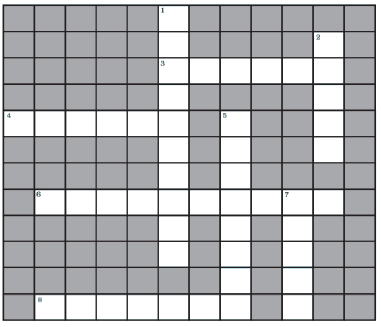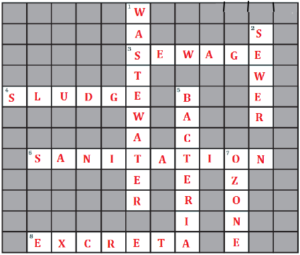Exercises
1.Fill in the blanks:
(a) Cleaning of water is a process of removing ____________.
(b) Wastewater released by houses is called ____________.
(c) Dried ____________ is used as manure.
(d) Drains get blocked by ____________ and ____________.
Answer.
(a) Cleaning of water is a process of removing pollutant.
(b) Wastewater released by houses is called sewage.
(c) Dried sludge is used as manure.
(d) Drains get blocked by oils and fats.
2.What is sewage? Explain why it is harmful to discharge untreated sewage into rivers or seas.
Answer. Sewage is a liquid waste which has water as its largest component along with various types of impurities like waste water from houses, offices, factories, hospitals etc., is called sewage. It has a complex mixture containing suspended solids, organic and inorganic impurities, nutrients, saprotrophic and disease causing bacteria and other microbes.
Discharging untreated sewage into rivers or seas will pollute the water resources. Contaminated water is dangerous for aquatic plants and animals. It also spread many diseases like cholera, typhoid, polio, meningitis, malaria, dengue etc.
3. Why should oils and fats be not released in the drain? Explain.
Answer. Oil and fats can clog the drains reducing its effectiveness in filtering water. In open drains, they block the pores in the soil and thus hamper the filtration by soil. Hence, oil and fats should not be released in the drain.
4. Describe the steps involved in getting clarified water from wastewater.
Answer. Treatment of wastewater involves physical, chemical, and biological processes, which remove physical, chemical and biological matter that contaminates the wastewater.
Following steps are involved:
- Wastewater is passed through bar screens which remove large objects like rags, sticks, cans, plastic packets, napkins etc.
- Water then goes through Grit and Sand removal tank, where sand, grit and pebbles settle down.
- Water is then allowed to settle in a tank where solids like faeces (called sludge) settle at the bottom and are removed with a scraper. A skimmer removes the floatable solids like oil and grease. Water so cleared is called clarified water. Sludge is used to produce biogas.
- Clarified water is then passed through an aerator tank where air is pumped into the water. It helps aerobic bacteria to grow which decompose organic matter like human waste.
- After several hours, the suspended microbes settle at the bottom of the tank as activated sludge. The water is then removed from the top. The dried activated sludge is used as manure.
- Water is removed from the top and is stored in a tank. The treated water has low level of organic material and suspended matter. It is discharged into a sea, a river or into the ground. Sometimes it is disinfected through chemicals like Chlorine and ozone and then distributed to towns.
5. What is sludge? Explain how it is treated.
Answer. Sludge is human waste (like faeces) in waste water left during sewage treatment. Since it is organic waste, it is used to produce bio gas and manure.
Sludge is collected by a scrapper. It is transferred to a separate tank where it is decomposed by the anaerobic bacteria. The biogas produced in the process can be used as fuel. After the aerator tank, microbes and human waste settle down and form activated sludge. The activated sludge is about 97% water. The water is removed by sand drying beds or machines. Dried sludge is used as manure, returning organic matter and nutrients to the soil.
6. Untreated human excreta is a health hazard. Explain.
Answer. Untreated human excreta contains many pathogens and disease causing microbe like cholera, diarrhea, typhoid, polio, meningitis, hepatitis etc. The germs of these diseases can easily reach human population through air, water or insects and through contaminated food and water. Thus, untreated human excreta are a health hazard.
7. Name two chemicals used to disinfect water.
Answer. Chemicals like chlorine (Chlorine dioxide) and ozone (in the pharmaceutical industry) are commonly used to disinfect water.
8. Explain the function of bar screens in a wastewater treatment plant.
Answer. Bar screens are used to remove large objects like rags, sticks, cans, plastic packets napkins, etc.
9. Explain the relationship between sanitation and disease.
Answer. A large number of diseases is caused due to poor sanitation and contaminated drinking water. Poor sanitation leads to growth of harmful microbes, flies and mosquitoes which are the source of spreading many diseases like cholera, typhoid, polio, meningitis, hepatitis and dysentery.
10. Outline your role as an active citizen in relation to sanitation.
Answer. Wastewater treatment plant requires costly infrastructure to build and to be maintained. So, we should be an active citizen and limit the type of waste. Try to follow the following:
- Open drains be covered and keep our surroundings clean.
- Should not litter anywhere adopt good sanitation practices e.g. oil and fats should not be thrown in drains.
- Chemicals like paints, insecticides, motor oil etc. should not be thrown in drain which may kill useful bacteria.
- Used tealeaves, solid food remains, soft toys, cotton, sanitary towels, etc. should also be thrown in the dustbin.
- Make people aware and encourage community practices to keep our environment clean.
- Separate trash as recycled waste and non-recycled.
11. Here is a crossword puzzle: Good luck!

Across
3. Liquid waste products
4. Solid waste extracted in sewage treatment
6. A word related to hygiene
8. Waste matter discharged from human body
Down
1. Used water
2. A pipe carrying sewage
5. Micro-organisms which causes cholera
7. A chemical to disinfect water
Answer.

12. Study the following statements about ozone:
(a) It is essential for breathing of living organisms.
(b) It is used to disinfect water.
(c) It absorbs ultraviolet rays.
(d) Its proportion in air is about 3%.
Which of these statements are correct?
(i) (a), (b) and (c)
(ii) (b) and (c)
(iii) (a) and (d)
(iv) All four
Answer. (ii) (b) and (c)
